PAdict, the "Personal Assistant Dictionary", offers EDICT based lookup for the PalmOS platform without requiring 3rd party libraries.
The download section has been removed from here, because this is an old version of the PAdict documentation. Please go to the actual version to find proper downloads!
Normally, I would advise you to start with the default dictionary file that comes with PAdict. But there are three other dictionaries available, a full one, a french one and an empty one. The full dictionary is much bigger, and tends to give you more results than you really want - on the other hand, there are more words in it. It's quite usefull if you have much storage capacity. The empty dictionary is simple empty. You can use it if you don't need a word dictioniary and want to use only the kanji recognition and information features of PAdict.
If you do not want an English dictionary, your choice is obviously more limited.
At the moment it is impossible to install more than one dictionary for PAdict; installing a second will overwrite the previously installed dictionary.
These are some installation guidelines to give you a better idea what to install on your device. Of course you can always decide to install more or drop some components, but this should help you out of the worst ignorance.
In all cases you must install: padict.prc, jstroke.pdb, jstroke_h.pdb, jstroke_k.pdb, radkfile.pdb and one dictionary, i.e. edict.pdb.
You have to install pkanjifnt.pdb. I'd recommend to install elisa.pdb, the small font; this enables the multiple result browser. You can also install only elisa.pdb to save some memory, but the small font is very hard to read, and this should only be done if you really can't spare 240 kB for the font.
If you have some memory left, kjdef.pdb (kanji information) and taka.pdb (stroke order diagrams) won't hurt. You never need pkj32x32.pdb, it's a high resolution font.
On a high resolution device it really pays off to install pkj32x32.pdb for high resolution fonts. It's recommended to keep pkanjfnt.pdb to get the multiple result browser. You never need elisa.pdb.
If you have some memory left, kjdef.pdb (kanji information) and taka.pdb (stroke order diagrams) won't hurt.
On a native japanese device, you don't have to install any font files at all; if you don't install them, PAdict will use the PalmOS-supplied fonts. It's a matter of taste, but for me the PAdict fonts look a little bit better. My advice: install the PAdict fonts if you can spare the memory, especially if you have a high resolution device. Look in the sections describing high and low resolution devices for more information what font files match your device best.
If your Palm supports a memory card, you can move all .pdb files from main memory to the memory card. Because reading on memory cards is slower than reading from main memory, this will have an impact on PAdicts overall speed, especially if you move the font or dictionary databases. PAdict will look for the files in the /Palm/Programs/PAdict/ directory. If you are looking for a free tool to move files to and from the memory card, you may want to try FileZ.

Once you have installed everything correctly, running PAdict will start up in "browse mode", and you can browse through every entry in your dictionary, with romaji, definitions, kana only and kanji/kani display. Of course, it is not likely you want to browse the whole dictionary.
Tapping the buttons below takes you to the many search options.
If the proper font databases have been installed, you can switch to the "multiple result browser" by tapping the button at the top of the screen. the result varies according to the model, but you should have at least four entries at at time to browse through, with their first definition. Tapping on the entry will take you back to the standard browsing screen, tapping on the "H>" will prompt you to add it to a hotlist.
You can always switch between the two browsing modes via the button at the top, (M) or (S).
The drop-down list on the top right side of the screen will let you switch between the full dictionary, your last search, and the hotlist.
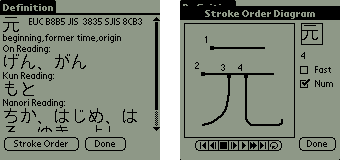
If you have installed the optional kjdef.pdb, you can either tap on kanji in the browse window or use the "Kanji" button from the search screens to get information about individual kanji, including pronunciations and lookup codes.
If taka.pdb has also been installed, you will have the option of seeing how each kanji is drawn, via the "Stroke order" button at the bottom.
The hotlist is similar to a set of bookmarks. Just like a search will generate a list to go through, adding an entry to the hotlist (or to your own custom list) will keep it for later review. All lists are available from the drop-down in the top right corner of the screen.

Enter your words via graffiti or on-screen keyboard. Searching with less frequently used words first (like "sleep to" in the example) does really speed up your search - grammar is not checked.
All the other search methods - Hiragana, Katakana, Romaji, PocketKanji, and Multiradical have a similar set of options. The first row of buttons - HKRKM - lets you to switch between the various search modes.
Second is a drop-down list. The default selection, "kana", which searches for exact matches in the kana reading. Also available is "kana*", which searches for any entries starting with those characters in the search string, and "kanji*", which works mostly like "kana*", but it looks for matches in the kanji reading instead of the kana reading. These modes are automatically switched between as needed.
"Search" does what one would expect it to do - start a search, taking you back to the browsing screen.
"Clear" removes all characters from the search string.
"Del" removes one character beforethe highlight, like backspace.
"Kanji" takes you to the Kanji information screen, if available.
"Cancel" returns you to your last list.
Refer to the following screenshots to see these options.
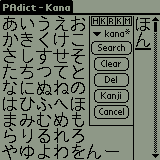
Tapping once on a kana character will add it to a search list. Tapping on a character in the search list will make it cycle through accented and small characters - try it! You can also insert characters you forgot by moving the highlight (click where you want it to be). The highlight mostly works as a normal text cursor.
Tapping on the characters in the search list, as in previous versions, cycles through their accented versions. An alternative is to enable "kana corner tap" or "kana double tap" in /menu/setup/preferences.
Kana corner tap takes a tap on the upper right corner of a kana in the table to add its soft counterpart. Those like ぱ, ぴ, ぷ, ぺ, and ぽ can be added by tapping the lower right corner.
Kana double tap, only working on PalmOS >= 4.0, does just the same - for example, tap は twice and get ば, three times to get ぱ.
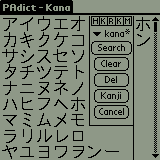
Strikingly similar to Hiragana Input.
 Use graffiti or the on-screen keyboard. One can
choose between hiragana and katakana interpretation.
Use graffiti or the on-screen keyboard. One can
choose between hiragana and katakana interpretation.
Users of the Japanese PalmOS default to an exclusive "direct" input option, shown in the screenshot, based off of standard system calls. Hiragana And Katakana are still available from the drop-down menu, if desired.
When switching in from another search mode, Kana characters are represented by their romaji equivalents, while Kanji are represented by their EUC number - unless in "direct" mode.
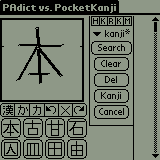
... is a great way to test your handwriting, including stroke order, if nothing else.
Just draw the character you want to add and tap either the Kanji, Hiragana, or Katakana buttons. Undo, clear, and redo are also available. Up to eight characters will appear; hopefully, one of them is the one you wanted. Tap it to add it to the search string.

With a new design for 0.3.1, the MultiRadical lookup method will search for a kanji by with to four radicals.
1. Select up to 4 radicals by tapping on them. Radicals are sorted by their stroke count; use the dropdown in the upper left corner to display the other radicals.
After being tapped, they appear in the small boxes along the bottom of the screen. Tapping on a radical in the box removes it.
2. If you know the stroke count of your kanji, enter it in the "stroke count" area. You can simply enter one value or a range if you are unsure.
3. Tap "lookup" and any matching kanji are displayed. If your kanji is there, tap it to add it to the search string. If you did not find your kanji, you can reset the whole form, or add more radicals. Results from your last search are always available through the "R" option in the radical selection dropdown. You can also change your stroke count and lookup again.
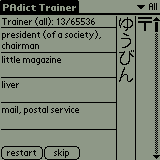
Most of the things listed here can be found in the main screen menus. Some are currently in development.
The Trainer - drill on dictionary entries
Preferences (in the "Browsing Screen" menu)
In-program Help
I'd like to mention the great edict project and Jim Breen, whose database we use. Thanks a lot!
Also I'd like to thank Ciaran Keating from Australia, who did much of the database search logic work here.
The hand writing recognition is based on PocketKanji by Ivan Kanis, which is based on jstroke by Robert Wells
Credit also goes to Stephan Matthiesen for revising the kanji recognition and making the database for kana recognition.
High resolution device support and fonts have been done by Benoit Cerrina, along with SOD integration.
Kenji Baheux worked on Japanese PalmOS integration.
Some old Palm Handhelds have been donated by Daniel Hauck.
The website and documentation for version 0.3.1 was developed by Sudrien, with help from pretty much everybody contributing - but who still can not remember the difference between ほ and ま.
PAdict was created (and is maintained) by Lars Grunewaldt.